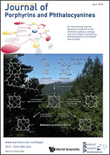
JOURNAL OF PORPHYRINS AND PHTHALOCYANINES
Scope & Guideline
Unveiling the Potential of Key Chemical Compounds
Introduction
Aims and Scopes
- Synthesis and Characterization of Porphyrins and Phthalocyanines:
The journal publishes articles detailing innovative synthetic methods and comprehensive characterization techniques for porphyrins and phthalocyanines, often highlighting novel derivatives and their unique properties. - Photophysical and Photochemical Properties:
Research focuses on studying the photophysical and photochemical behaviors of porphyrins and phthalocyanines, including their interactions with light and potential applications in photodynamic therapy and solar energy conversion. - Applications in Photodynamic Therapy and Antimicrobial Activity:
A significant portion of the research explores the application of porphyrins and phthalocyanines in medical fields, particularly their roles as photosensitizers in photodynamic therapy for cancer treatment and their antimicrobial properties. - Electrochemical Properties and Catalytic Activity:
The journal features studies on the electrochemical behavior of porphyrins and phthalocyanines, investigating their potential as catalysts in various chemical reactions, including oxidation processes and energy conversion. - Nanomaterials and Hybrid Systems:
Research on the integration of porphyrins and phthalocyanines into nanomaterials and hybrid systems is prevalent, exploring their use in enhancing performance in applications such as drug delivery, sensors, and environmental remediation.
Trending and Emerging
- Nanotechnology and Hybrid Systems:
There is a growing interest in utilizing porphyrins and phthalocyanines in nanotechnology, including their incorporation into nanomaterials and hybrid systems for enhanced functionality in drug delivery and catalysis. - Photodynamic Therapy Innovations:
Research focusing on advancements in photodynamic therapy, including the development of new photosensitizers and methodologies, is increasingly prominent, emphasizing their potential in cancer treatment and antimicrobial applications. - Green Chemistry and Sustainable Synthesis:
Emerging studies emphasize sustainable and environmentally friendly synthesis methods for porphyrins and phthalocyanines, aligning with global movements towards greener chemistry practices. - Multifunctional Materials:
The trend towards creating multifunctional materials that leverage the unique properties of porphyrins and phthalocyanines for diverse applications, including sensors and energy conversion, is on the rise. - Computational Chemistry and Theoretical Studies:
An increasing number of publications are employing computational methods to predict and analyze the behavior of porphyrins and phthalocyanines, enhancing the understanding of their properties and guiding experimental work.
Declining or Waning
- Traditional Chemical Synthesis Methods:
While traditional synthesis methods were once a primary focus, there is a noticeable shift towards more innovative and efficient synthesis techniques, such as microwave-assisted or green chemistry approaches. - Basic Structural Studies:
Research centered solely on the basic structural characterization of porphyrins and phthalocyanines is becoming less common, as studies increasingly emphasize functional applications and interdisciplinary approaches. - Synthetic Pathways without Functionalization:
There is a decline in publications that describe synthetic pathways that do not lead to functionalized or application-oriented derivatives, as the emphasis is now more on tailoring properties for specific uses. - Standalone Photochemical Studies:
Studies that examine photochemical properties in isolation, without linking them to practical applications, are less frequently published, reflecting a broader trend towards applied research. - In vitro Studies without Contextual Application:
Research focused solely on in vitro studies without a clear connection to therapeutic applications or real-world implications is diminishing, as the journal encourages findings that translate to practical uses.
Similar Journals
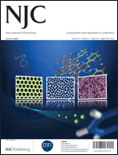
NEW JOURNAL OF CHEMISTRY
Advancing the Frontiers of Chemistry and Materials ScienceNEW JOURNAL OF CHEMISTRY, published by the prestigious Royal Society of Chemistry, serves as a vital platform for the dissemination of research in the dynamic fields of chemistry, catalysis, and materials science. With an impressive ISSN of 1144-0546, this journal boasts a rich history, having been established in 1996, and is set to continue its impactful publication through 2024. The journal is recognized in several categories, achieving a Q2 ranking in both chemistry and materials chemistry, and a Q3 rank in catalysis, reflecting its significance within these disciplines. Researchers will find it particularly noteworthy that the journal holds an esteemed position in the Scopus rankings, with a 65th percentile standing in general chemistry. Though it currently operates on a subscription model, its commitment to advancing the frontiers of chemistry makes it an essential resource for academics, professionals, and students seeking to keep abreast of the latest advancements and innovative methodologies in their fields.
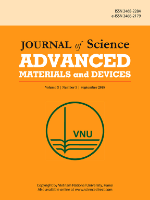
Journal of Science-Advanced Materials and Devices
Unleashing Potential: Where Science Meets InnovationJournal of Science-Advanced Materials and Devices is a leading open-access journal published by Vietnam National University, dedicated to advancing the field of materials science through cutting-edge research and innovative developments. Since its inception in 2016, this journal has become a pivotal platform for sharing insights and discoveries in various subfields, including biomaterials, ceramics and composites, and electronic, optical, and magnetic materials. With impressive quartile rankings, including Q1 across multiple categories in 2023, and a notable Scopus ranking placing it in the top 15th percentile for ceramics and composites, it highlights the journal’s influence and prestige within the global academic community. Open Access since its launch, the journal aims to facilitate unrestricted dissemination of scholarly work, empowering researchers, professionals, and students to engage with the latest advancements. The Journal of Science-Advanced Materials and Devices is vital for those seeking high-quality contributions that influence both theoretical understanding and practical applications in the ever-evolving landscape of materials science.

Frontiers in Nanotechnology
Unlocking the Future of Nanotechnology for AllFrontiers in Nanotechnology, published by FRONTIERS MEDIA SA, is an esteemed open access journal that has established itself as a premier platform for the dissemination of innovative research in the rapidly evolving field of nanotechnology since its inception. Based in Switzerland, the journal is dedicated to advancing knowledge across multiple disciplines, including Atomic and Molecular Physics, Biomedical Engineering, Electrical and Electronic Engineering, and Computer Science Applications. With a remarkable track record, it maintains a commendable Category Quartile ranking of Q2 across various fields in 2023, highlighting its influence and the quality of research it publishes. Researchers will find this journal an essential resource for accessing cutting-edge developments and findings, enriched by its strong performance in Scopus rankings—positioned firmly within the top percentiles in key areas. As an open access publication since 2020, Frontiers in Nanotechnology champions the democratization of knowledge, ensuring that the latest advancements are freely available to the global academic community, enhancing collaborative efforts and driving innovation.

Magnetochemistry
Shaping the Future of Magnetic ResearchMagnetochemistry is a premier academic journal dedicated to the study of magnetic phenomena in chemistry, published by MDPI, a globally recognized publisher known for its dedication to open science. Since its inception in 2015, this Open Access journal has provided a platform for researchers to share their findings and innovations in the fields of chemistry, particularly in the areas of electronic, optical, and magnetic materials. With a commendable impact factor and competitive ranking, including Q2 in miscellaneous chemistry and materials chemistry, and achieving notable placements within the Scopus ranks, Magnetochemistry stands out as a vital resource for professionals and students alike. By facilitating access to groundbreaking research, it significantly contributes to the advancement of the field, encouraging collaboration and further exploration among its diverse readership. Located in Switzerland, Magnetochemistry offers not only accessibility through its open access model but also a commitment to high-quality and impactful research outputs.
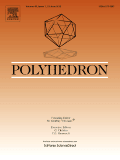
POLYHEDRON
Unveiling the Complexities of Molecular Structures.POLYHEDRON is a prestigious academic journal published by Pergamon-Elsevier Science Ltd, specializing in the fields of Inorganic Chemistry, Materials Chemistry, and Physical and Theoretical Chemistry. With its ISSN 0277-5387 and E-ISSN 1873-3719, the journal has been a significant outlet for groundbreaking research since its inception in 1982 and continues to be influential for scholars and practitioners. As of 2023, it holds a Q3 quartile ranking across its categorization, underscoring its impact within the scientific community with respectable Scopus Rankings that place it in the top percentiles of relevant fields. Situated in the United Kingdom, POLYHEDRON aims to foster the exchange of innovative ideas and findings related to polyhedral molecules and structures, making it an essential resource for researchers seeking to expand their knowledge and contribute to these dynamic areas of study. While currently not an Open Access journal, it remains committed to advancing education and research by providing quality content that serves both academic and practical applications.

JOURNAL OF SOL-GEL SCIENCE AND TECHNOLOGY
Elevating Knowledge in Sol-Gel ProcessesJOURNAL OF SOL-GEL SCIENCE AND TECHNOLOGY, published by Springer, is a vital resource within the interdisciplinary fields of materials science and engineering, focusing on innovative research related to sol-gel processes and applications. With a rich publication history spanning from 1993, this journal enables the dissemination of cutting-edge findings in biomaterials, ceramics, and composites, ranking impressively across various categories—Q3 in Biomaterials and Q2 in several other materials-related fields. The journal's commitment to quality research is reflected in its Scopus rankings, particularly notable in the categories of Condensed Matter Physics and Materials Chemistry. Researchers and professionals leveraging the insights from this journal are supported through its comprehensive scope, which bridges theoretical foundations with practical applications, advancing knowledge and fostering collaboration among academics and industry leaders alike. As a non-open access journal, it is essential for subscribers and institutions to engage deeply with the latest advancements documented within its pages, underscoring the journal's role in shaping the future of sol-gel science and technology.
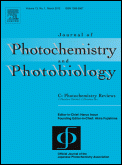
JOURNAL OF PHOTOCHEMISTRY AND PHOTOBIOLOGY C-PHOTOCHEMISTRY REVIEWS
Illuminating Innovations in PhotochemistryThe JOURNAL OF PHOTOCHEMISTRY AND PHOTOBIOLOGY C-PHOTOCHEMISTRY REVIEWS, published by Elsevier, is a premier scholarly journal that serves as a critical resource for researchers and professionals in the field of photochemistry and photobiology. With a distinguished Q1 ranking in key categories such as Catalysis, Organic Chemistry, and Physical and Theoretical Chemistry, this journal consistently publishes high-impact articles that contribute significantly to the advancement of knowledge in these disciplines. The journal's rigorous peer-review process ensures the integrity and quality of the research it disseminates. Researchers benefit from its comprehensive review articles that discuss recent advancements, theoretical developments, and practical applications of photochemical processes, making it an essential read for anyone in the field. The journal's impact and relevance are evidenced by its impressive Scopus rankings, including a top percentile of 98th in Organic Chemistry. As the journal continues to explore innovative and interdisciplinary approaches, it stands out as a vital platform for sharing and discussing cutting-edge research findings within the community.

MACROMOLECULAR RESEARCH
Connecting Researchers in the World of PolymersMACROMOLECULAR RESEARCH, published by the POLYMER SOC KOREA, is a premier journal dedicated to advancing the field of macromolecular science and polymer engineering. With its ISSN 1598-5032 and E-ISSN 2092-7673, this journal has emerged as a vital platform for researchers and professionals interested in the application and development of polymers across various domains. Based in South Korea and operating as an open-access resource since its inception in 2002, MACROMOLECULAR RESEARCH consistently ranks in the Q2 category across diverse fields such as Chemical Engineering, Materials Chemistry, and Organic Chemistry as per the latest 2023 metrics. Notably, it is recognized for its substantial contributions to polymery science, increasing its visibility and impact in global research. By providing a forum for original research articles, reviews, and innovative methodologies, this journal aims to foster collaboration and knowledge sharing among scientists, engineers, and students alike. Join a community that is at the forefront of polymer research by exploring the wealth of resources and cutting-edge studies featured in MACROMOLECULAR RESEARCH.

Macroheterocycles
Illuminating the Path of Chemical InnovationMacroheterocycles is a premier academic journal dedicated to the exploration and advancement of Analytical Chemistry and Organic Chemistry, published by the esteemed Ivanovo State University of Chemical Technology. Since its inception in 2008, this open-access journal has focused on providing a platform for innovative research and breakthrough discoveries in the field of heterocyclic compounds. With its current ranking in the Q3 quartile for Analytical Chemistry and Q4 quartile for Organic Chemistry, Macroheterocycles is rapidly establishing itself as a valuable resource for scientists, researchers, and students seeking to enrich their understanding of complex chemical structures and analytical techniques. Its comprehensive publication model ensures that the latest findings are accessible to a global audience, fostering collaboration and discourse in the scientific community. With ongoing contributions aimed at addressing contemporary challenges in chemistry, this journal is poised to make significant impacts in the field while encouraging the dissemination of knowledge within and beyond Russia.
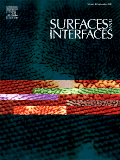
Surfaces and Interfaces
Pioneering Research in Surface and Coating TechnologiesSurfaces and Interfaces is a leading international journal published by Elsevier, dedicated to advancing the understanding of surface and interfacial phenomena across various disciplines, including chemistry, materials science, and physics. With an impressive impact factor placing it in the Q1 quartile for its categories as of 2023—spanning Chemistry, Condensed Matter Physics, and Surfaces, Coatings, and Films—this journal not only serves as a critical platform for innovative research but also reflects the dynamic nature of surface science in contemporary applications. The journal is indexed in Scopus, ranking 25th out of 132 in the Materials Science – Surfaces, Coatings and Films category, marking it in the top 19% of this prestigious field. Although it is not an open-access platform, the journal remains a vital source of curated academic material for researchers, professionals, and students seeking to deepen their knowledge and contribute to ongoing conversations in surface and interface science. Published from the heart of Europe in Amsterdam, Surfaces and Interfaces invites submissions that challenge conventional paradigms and explore the forefront of technology and materials.